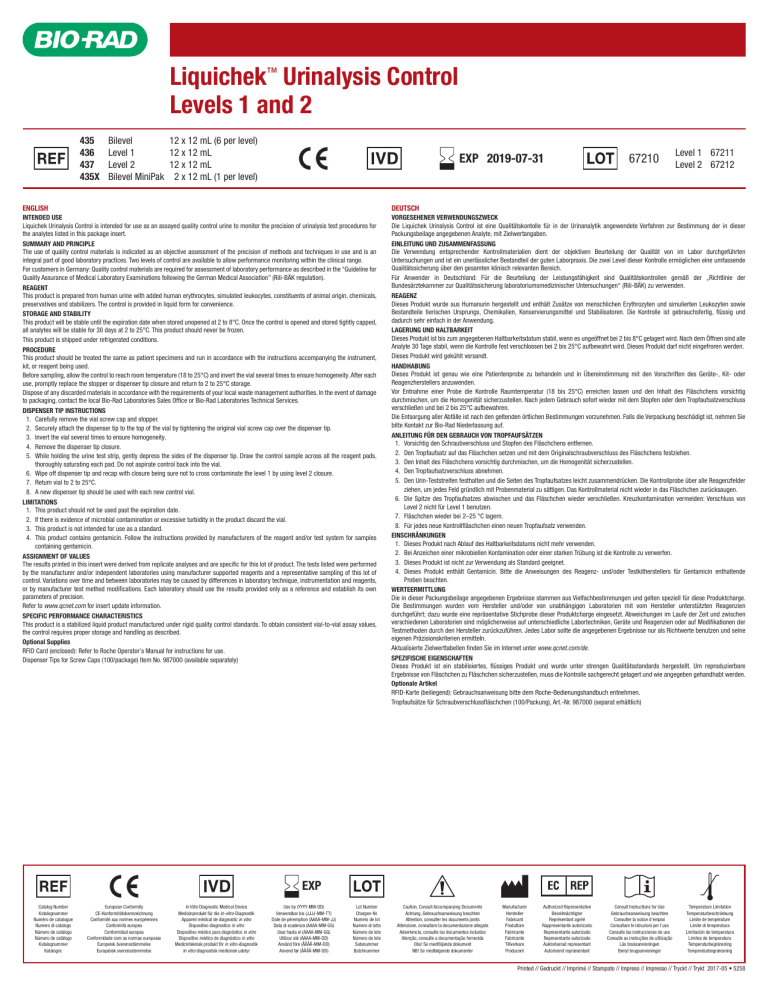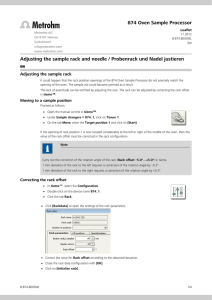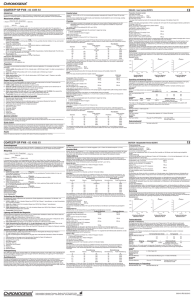
Liquichek™ Urinalysis Control Levels 1 and 2 435 436 437 435X Bilevel 12 x 12 mL (6 per level) Level 1 12 x 12 mL Level 2 12 x 12 mL Bilevel MiniPak 2 x 12 mL (1 per level) EXP 2019-07-31 67210 Level 1 67211 Level 2 67212 ENGLISH DEUTSCH INTENDED USE Liquichek Urinalysis Control is intended for use as an assayed quality control urine to monitor the precision of urinalysis test procedures for the analytes listed in this package insert. SUMMARY AND PRINCIPLE The use of quality control materials is indicated as an objective assessment of the precision of methods and techniques in use and is an integral part of good laboratory practices. Two levels of control are available to allow performance monitoring within the clinical range. For customers in Germany: Quality control materials are required for assessment of laboratory performance as described in the “Guideline for Quality Assurance of Medical Laboratory Examinations following the German Medical Association” (Rili-BÄK regulation). REAGENT This product is prepared from human urine with added human erythrocytes, simulated leukocytes, constituents of animal origin, chemicals, preservatives and stabilizers. The control is provided in liquid form for convenience. STORAGE AND STABILITY This product will be stable until the expiration date when stored unopened at 2 to 8°C. Once the control is opened and stored tightly capped, all analytes will be stable for 30 days at 2 to 25°C. This product should never be frozen. This product is shipped under refrigerated conditions. PROCEDURE This product should be treated the same as patient specimens and run in accordance with the instructions accompanying the instrument, kit, or reagent being used. Before sampling, allow the control to reach room temperature (18 to 25°C) and invert the vial several times to ensure homogeneity. After each use, promptly replace the stopper or dispenser tip closure and return to 2 to 25°C storage. Dispose of any discarded materials in accordance with the requirements of your local waste management authorities. In the event of damage to packaging, contact the local Bio-Rad Laboratories Sales Office or Bio-Rad Laboratories Technical Services. DISPENSER TIP INSTRUCTIONS 1. Carefully remove the vial screw cap and stopper. 2. Securely attach the dispenser tip to the top of the vial by tightening the original vial screw cap over the dispenser tip. 3. Invert the vial several times to ensure homogeneity. 4. Remove the dispenser tip closure. 5. While holding the urine test strip, gently depress the sides of the dispenser tip. Draw the control sample across all the reagent pads, thoroughly saturating each pad. Do not aspirate control back into the vial. 6. Wipe off dispenser tip and recap with closure being sure not to cross contaminate the level 1 by using level 2 closure. 7. Return vial to 2 to 25°C. 8. A new dispenser tip should be used with each new control vial. LIMITATIONS 1. This product should not be used past the expiration date. 2. If there is evidence of microbial contamination or excessive turbidity in the product discard the vial. 3. This product is not intended for use as a standard. 4. This product contains gentamicin. Follow the instructions provided by manufacturers of the reagent and/or test system for samples containing gentamicin. ASSIGNMENT OF VALUES The results printed in this insert were derived from replicate analyses and are specific for this lot of product. The tests listed were performed by the manufacturer and/or independent laboratories using manufacturer supported reagents and a representative sampling of this lot of control. Variations over time and between laboratories may be caused by differences in laboratory technique, instrumentation and reagents, or by manufacturer test method modifications. Each laboratory should use the results provided only as a reference and establish its own parameters of precision. Refer to www.qcnet.com for insert update information. SPECIFIC PERFORMANCE CHARACTERISTICS This product is a stabilized liquid product manufactured under rigid quality control standards. To obtain consistent vial-to-vial assay values, the control requires proper storage and handling as described. Optional Supplies RFID Card (enclosed): Refer to Roche Operator’s Manual for instructions for use. Dispenser Tips for Screw Caps (100/package) Item No. 987000 (available separately) VORGESEHENER VERWENDUNGSZWECK Die Liquichek Urinalysis Control ist eine Qualitätskontolle für in der Urinanalytik angewendete Verfahren zur Bestimmung der in dieser Packungsbeilage angegebenen Analyte, mit Zielwertangaben. EINLEITUNG UND ZUSAMMENFASSUNG Die Verwendung entsprechender Kontrollmaterialien dient der objektiven Beurteilung der Qualität von im Labor durchgeführten Untersuchungen und ist ein unerlässlicher Bestandteil der guten Laborpraxis. Die zwei Level dieser Kontrolle ermöglichen eine umfassende Qualitätssicherung über den gesamten klinisch relevanten Bereich. Für Anwender in Deutschland: Für die Beurteilung der Leistungsfähigkeit sind Qualitätskontrollen gemäß der „Richtlinie der Bundesärztekammer zur Qualitätssicherung laboratoriumsmedizinischer Untersuchungen“ (Rili-BÄK) zu verwenden. REAGENZ Dieses Produkt wurde aus Humanurin hergestellt und enthält Zusätze von menschlichen Erythrozyten und simulierten Leukozyten sowie Bestandteile tierischen Ursprungs, Chemikalien, Konservierungsmittel und Stabilisatoren. Die Kontrolle ist gebrauchsfertig, flüssig und dadurch sehr einfach in der Anwendung. LAGERUNG UND HALTBARKEIT Dieses Produkt ist bis zum angegebenen Haltbarkeitsdatum stabil, wenn es ungeöffnet bei 2 bis 8°C gelagert wird. Nach dem Öffnen sind alle Analyte 30 Tage stabil, wenn die Kontrolle fest verschlossen bei 2 bis 25°C aufbewahrt wird. Dieses Produkt darf nicht eingefroren werden. Dieses Produkt wird gekühlt versandt. HANDHABUNG Dieses Produkt ist genau wie eine Patientenprobe zu behandeln und in Übereinstimmung mit den Vorschriften des Geräte-, Kit- oder Reagenzherstellers anzuwenden. Vor Entnahme einer Probe die Kontrolle Raumtemperatur (18 bis 25°C) erreichen lassen und den Inhalt des Fläschchens vorsichtig durchmischen, um die Homogenität sicherzustellen. Nach jedem Gebrauch sofort wieder mit dem Stopfen oder dem Tropfaufsatzverschluss verschließen und bei 2 bis 25°C aufbewahren. Die Entsorgung aller Abfälle ist nach den geltenden örtlichen Bestimmungen vorzunehmen. Falls die Verpackung beschädigt ist, nehmen Sie bitte Kontakt zur Bio-Rad Niederlassung auf. ANLEITUNG FÜR DEN GEBRAUCH VON TROPFAUFSÄTZEN 1. Vorsichtig den Schraubverschluss und Stopfen des Fläschchens entfernen. 2. Den Tropfaufsatz auf das Fläschchen setzen und mit dem Originalschraubverschluss des Fläschchens festziehen. 3. Den Inhalt des Fläschchens vorsichtig durchmischen, um die Homogenität sicherzustellen. 4. Den Tropfaufsatzverschluss abnehmen. 5. Den Urin-Teststreifen festhalten und die Seiten des Tropfaufsatzes leicht zusammendrücken. Die Kontrollprobe über alle Reagenzfelder ziehen, um jedes Feld gründlich mit Probenmaterial zu sättigen. Das Kontrollmaterial nicht wieder in das Fläschchen zurücksaugen. 6. Die Spitze des Tropfaufsatzes abwischen und das Fläschchen wieder verschließen. Kreuzkontamination vermeiden: Verschluss von Level 2 nicht für Level 1 benutzen. 7. Fläschchen wieder bei 2–25 °C lagern. 8. Für jedes neue Kontrollfläschchen einen neuen Tropfaufsatz verwenden. EINSCHRÄNKUNGEN 1. Dieses Produkt nach Ablauf des Haltbarkeitsdatums nicht mehr verwenden. 2. Bei Anzeichen einer mikrobiellen Kontamination oder einer starken Trübung ist die Kontrolle zu verwerfen. 3. Dieses Produkt ist nicht zur Verwendung als Standard geeignet. 4. Dieses Produkt enthält Gentamicin. Bitte die Anweisungen des Reagenz- und/oder Testkitherstellers für Gentamicin enthaltende Proben beachten. WERTEERMITTLUNG Die in dieser Packungsbeilage angegebenen Ergebnisse stammen aus Vielfachbestimmungen und gelten speziell für diese Produktcharge. Die Bestimmungen wurden vom Hersteller und/oder von unabhängigen Laboratorien mit vom Hersteller unterstützten Reagenzien durchgeführt; dazu wurde eine repräsentative Stichprobe dieser Produktcharge eingesetzt. Abweichungen im Laufe der Zeit und zwischen verschiedenen Laboratorien sind möglicherweise auf unterschiedliche Labortechniken, Geräte und Reagenzien oder auf Modifikationen der Testmethoden durch den Hersteller zurückzuführen. Jedes Labor sollte die angegebenen Ergebnisse nur als Richtwerte benutzen und seine eigenen Präzisionskriterien ermitteln. Aktualisierte Zielwerttabellen finden Sie im Internet unter www.qcnet.com/de. SPEZIFISCHE EIGENSCHAFTEN Dieses Produkt ist ein stabilisiertes, flüssiges Produkt und wurde unter strengen Qualitätsstandards hergestellt. Um reproduzierbare Ergebnisse von Fläschchen zu Fläschchen sicherzustellen, muss die Kontrolle sachgerecht gelagert und wie angegeben gehandhabt werden. Optionale Artikel RFID-Karte (beiliegend): Gebrauchsanweisung bitte dem Roche-Bedienungshandbuch entnehmen. Tropfaufsätze für Schraubverschlussfläschchen (100/Packung), Art.-Nr. 987000 (separat erhältlich) EXP Catalog Number Katalognummer Numéro de catalogue Numero di catalogo Número de catálogo Número de catálogo Katalognummer Katalognr. European Conformity CE-Konformitätskennzeichnung Conformité aux normes européennes Conformità europea Conformidad europea Conformidade com as normas europeias Europeisk överensstämmelse Europæisk overensstemmelse In Vitro Diagnostic Medical Device Medizinprodukt für die In-vitro-Diagnostik Appareil médical de diagnostic in vitro Dispositivo diagnostico in vitro Dispositivo médico para diagnóstico in vitro Dispositivo médico de diagnóstico in vitro Medicinteknisk produkt för in vitro-diagnostik In vitro diagnostisk medicinsk udstyr Use by (YYYY-MM-DD) Verwendbar bis (JJJJ-MM-TT) Date de péremption (AAAA-MM-JJ) Data di scadenza (AAAA-MM-GG) Usar hasta el (AAAA-MM-GG) Utilizar até (AAAA-MM-DD) Använd före (ÅÅÅÅ-MM-DD) Anvend før (ÅÅÅÅ-MM-DD) Lot Number Chargen-Nr. Numéro de lot Numero di lotto Número de lote Número de lote Satsnummer Batchnummer Caution, Consult Accompanying Documents Achtung, Gebrauchsanweisung beachten Attention, consulter les documents joints Attenzione, consultare la documentazione allegata Advertencia, consulte los documentos incluidos Atenção, consulte a documentação fornecida Obs! Se medföljande dokument NB! Se medfølgende dokumenter Manufacturer Hersteller Fabricant Produttore Fabricante Fabricante Tillverkare Producent Authorized Representative Bevollmächtigter Représentant agréé Rappresentante autorizzato Representante autorizado Representante autorizado Auktoriserad representant Autoriseret repræsentant Consult Instructions for Use Gebrauchsanweisung beachten Consulter la notice d’emploi Consultare le istruzioni per l’uso Consulte las instrucciones de uso Consulte as instruções de utilização Läs bruksanvisningen Benyt brugsanvisninger Temperature Limitation Temperaturbeschränkung Limite de température Limite di temperatura Limitación de temperatura Limites de temperatura Temperaturbegränsning Temperaturbegrænsning Printed // Gedruckt // Imprimé // Stampato // Impreso // Impresso // Tryckt // Trykt 2017-05 • 5258 Manufacturer/Method Analyte Level 1 – 67211 Level 2 – 67212 Normal Negative Negative Negative 5–7 Negative 1.005 – 1.020 Normal 250 – 1000 mg/dL (14 – 56 mmol/L) 2+ – 3+ (Mod. – Large) 25 – 500 Leu/μL (Trace – 2+) Positive 6–8 100 – 500 mg/dL (2+ – 3+) 1.000 – 1.015 8 – 12 mg/dL Negative Negative Normal Negative Negative Negative 5–7 Negative 1.005 – 1.020 Normal 3 – 6 mg/dL (50 – 100 μmol/L) (2+ – 3+) 50 – 250 Ery/μL (2+ – 3+) 250 – >1000 mg/dL (14 – >56 mmol/L) 15 – 150 mg/dL (1.5 – 15 mmol/L) (1+ – 3+) 75 – 500 Leu/μL (1+ – 2+) Positive 7–8 100 – 500 mg/dL (1.0 – 5.0 g/L) (2+ – 3+) 1.000 – 1.020 8 – ≥12 mg/dL (135 – ≥203 μmol/L) (3+ – 4+) Negative Negative Normal Negative Negative Negative 5 – 6.5 Negative 1.005– 1.020 Normal 3 – 6 mg/dL (50 – 100 μmol/L) (2+ – 3+) 150 – 250 Ery/μL (3+ – 4+) 250 – 1000 mg/dL (14 – 56 mmol/L) (2+ – 3+) 50 – 150 mg/dL (5.0 – 15 mmol/L) (2+ – 3+) 100 – 500 Leu/μL Positive 7–8 100 – 500 mg/dL (1.0 – 5.0 g/L) (2+ – 3+) 1.000 – 1.020 8 – 12 mg/dL (135 – 203 μmol/L) (3+ – 4+) Negative 20 – 100 mg/L Negative Negative Normal Negative Negative Negative 5 – 6.5 Negative 1.005 – 1.020 Normal 3 – 6 mg/dL (50 – 100 μmol/L) (2+ – 3+) 150 – 250 Ery/μL (4+ – 5+) 300 – 1000 mg/dL (18 – 56 mmol/L) (3+ – 4+) 50 – 150 mg/dL (5.0 – 15 mmol/L) (3+ – 4+) 100 – 500 Leu/μL (2+ – 3+) Positive 7–8 150 – 500 mg/dL (1.5 – 5.0 g/L) (3+ – 4+) 1.000 – 1.020 8 – 12 mg/dL (135 – 203 μmol/L) (3+ – 4+) Negative Negative Normal Negative Negative Negative 5 – 6.5 Negative 1.005 – 1.015 Normal 3 – 6 mg/dL (50 – 100 μmol/L) (2+ – 3+) 150 – 250 Ery/μL 100 – 1000 mg/dL (6 – 56 mmol/L) (1+ – 3+) 50 – 150 mg/dL (5 – 15 mmol/L) (2+ – 3+) 100 – 500 Leu/μL (1+ – 2+) Positive 7–8 100 – 500 mg/dL (1.0 – 5.0 g/L) (2+ – 3+) 1.000 – 1.020 8 – 12 mg/dL (135 – 203 μmol/L) (2+ – 3+) Negative Negative Normal Negative Negative Negative 5 – 6.5 Negative 1.005 – 1.020 Normal 3 – 6 mg/dL (50 – 100 μmol/L) (2+ – 3+) 150 – 250 Ery/μL (4+ – 5+) 250 – 1000 mg/dL (14 – 56 mmol/L) (3+ – 4+) 50 – 150 mg/dL (5 – 15 mmol/L) (3+ – 4+) 100 – 500 Leu/μL (2+ – 3+) Positive 7–8 100 – 500 mg/dL (1.0 – 5.0 g/L) (3+ – 4+) 1.000 – 1.020 8 – 12 mg/dL (135 – 203 μmol/L) (3+ – 4+) Negative Negative Normal Negative Negative Negative 5 – 6.5 Negative 1.005 – 1.020 Normal 3 – 6 mg/dL (50 – 100 μmol/L) (2+ – 3+) 50 – 250 Ery/μL (1+ – 2+) 250 – >1000 mg/dL (14 – >56 mmol/L) (2+ – 3+) 50 – 150 mg/dL (5 – 15 mmol/L) (2+ – 3+) 75 – 500 Leu/μL (1+ – 2+) Positive 6.5 – 8 100 – 500 mg/dL (1.0 – 5.0 g/L) (2+ – 3+) 1.000 – 1.020 8 – ≥12 mg/dL (135 – ≥203 μmol/L) (3+ – 4+) Negative Negative Normal Normal Negative Negative 5 – 6.5 Negative 3 – 6 mg/dL (50 – 100 μmol/L) (2+ – 3+) 150 – 250 Ery/μL (4+ – 5+) 250 – 1000 mg/dL (14 – 56 mmol/L) (3+ – 4+) 50 – 150 mg/dL (5 – 15 mmol/L) (3+ – 4+) 100 – 500 Leu/μL (2+ – 3+) Positive 7–8 100 – 500 mg/dL (1.0 – 5.0 g/L) (3+ – 4+) ROCHE CHEMSTRIP 10 URINE TEST STRIPS (VISUAL) (1) (5) (continued) Glucose Ketones Leukocytes Nitrite pH Protein, Total Specific Gravity Urobilinogen ROCHE CHEMSTRIP 101 / URILUX S ANALYZERS (5) Bilirubin Blood Glucose Ketones Leukocytes Nitrite pH Protein, Total Specific Gravity Urobilinogen ROCHE CHEMSTRIP CRITERION ANALYZER (5) Bilirubin Blood Glucose Ketones Leukocytes Nitrite pH Protein, Total Specific Gravity Urobilinogen ROCHE CHEMSTRIP MICRAL (VISUAL) (5) Microalbumin ROCHE CHEMSTRIP MIDITRON JUNIOR ANALYZER (5) Bilirubin Blood Glucose Ketones Leukocytes Nitrite pH Protein, Total Specific Gravity Urobilinogen ROCHE CHEMSTRIP UA / MIDITRON M ANALYZERS (5) Bilirubin Blood Glucose Ketones Leukocytes Nitrite pH Protein, Total Specific Gravity Urobilinogen ROCHE COBAS U 411 ANALYZER (5) Bilirubin Blood Glucose Ketones Leukocytes Nitrite pH Protein, Total Specific Gravity Urobilinogen ROCHE URISYS 1100 ANALYZER (5) Bilirubin Blood Glucose Ketones Leukocytes Nitrite pH Protein, Total Specific Gravity Urobilinogen ROCHE URISYS 1800 ANALYZER (5) Bilirubin Blood Glucose Ketones Leukocytes Nitrite pH Protein, Total

